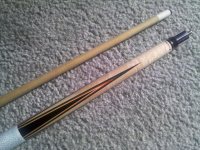I was looking at some old Gus Szamboti cues the other day and I noticed that the forearms had a beautiful honey look to them. I was told that this was from age.
Would it be possible to recreate that look on a newer cue on the forearm.
I have a Eddie Farris cue that I love, it's got the old school look and I think that honey look would look great on my cue.
I'll attach a picture of my forearm.
If any one of you guy's could accomplish this please let me know.
Thanks - Tommyd1
Would it be possible to recreate that look on a newer cue on the forearm.
I have a Eddie Farris cue that I love, it's got the old school look and I think that honey look would look great on my cue.
I'll attach a picture of my forearm.
If any one of you guy's could accomplish this please let me know.
Thanks - Tommyd1
Attachments
Last edited:
